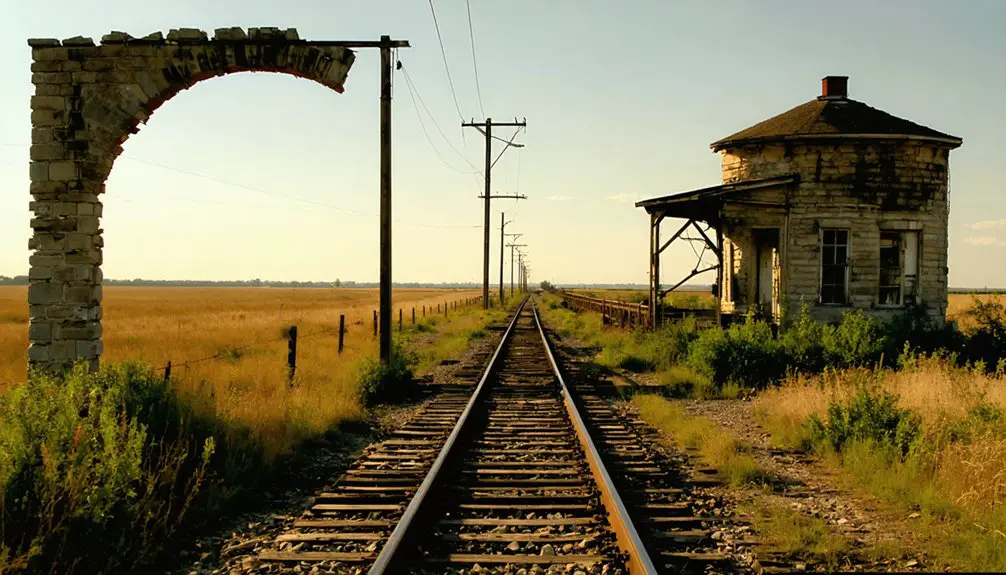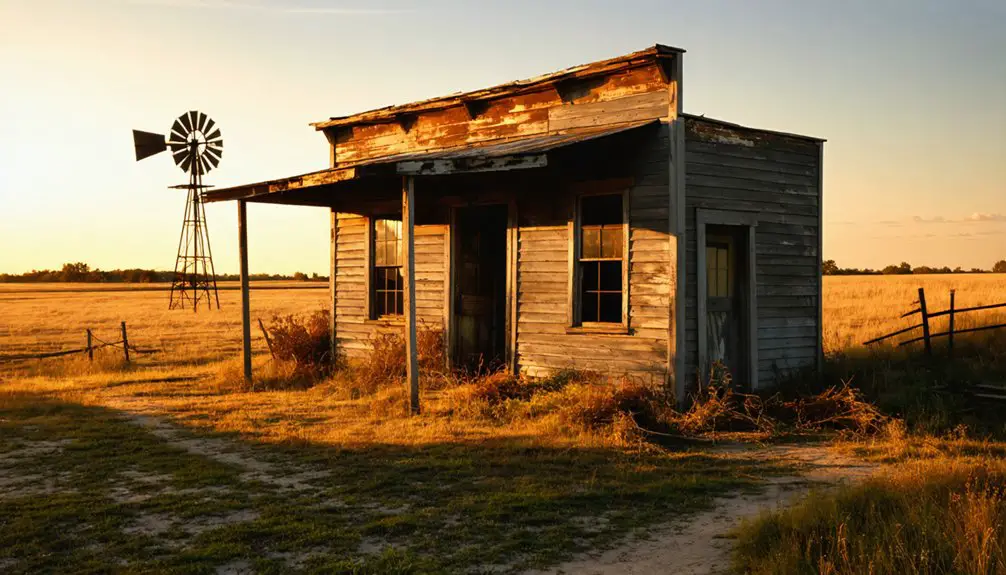You’ll find Gibson Station’s remains where the Missouri-Kansas-Texas Railroad first reached Indian Territory in 1871. This ghost town started as an essential railway terminus, with Oklahoma’s first permanent depot built in 1872 under Captain George Shannon’s supervision. The settlement thrived through the 1880s with the McAnnally family’s Cottonwood Hotel serving railroad workers and travelers. While the town faded after the Arkansas River bridge redirected traffic, its legacy as a significant transportation hub holds deeper stories beneath the surface.
Key Takeaways
- Gibson Station was established in 1871 as a Missouri-Kansas-Texas Railroad terminus in Indian Territory, featuring Oklahoma’s first permanent railway depot.
- The community thrived as a transportation hub with regular stagecoach service to Fort Gibson and significant railroad operations.
- Economic success peaked in 1895 with the railroad generating $1.2 million in passenger earnings and $3 million in freight.
- The town declined after the Arkansas River bridge redirected traffic and Fort Gibson military post closed in 1890.
- Gibson Station transformed from bustling railway center to ghost town as railroad companies relocated facilities and economic opportunities diminished.
The Birth of a Railway Settlement (1870s)
When the Missouri-Kansas-Texas Railroad pushed south through Indian Territory in 1871, Gibson Station emerged as a critical terminus point just six miles from its tracks’ end.
You’d have witnessed remarkable railroad innovation as Captain George Shannon oversaw the construction of essential infrastructure, including a turntable for engines and Oklahoma’s first permanent railway depot in 1872.
The settlement faced unique challenges as military forces from the nearby Fort Gibson helped maintain order during construction, policing railroad camps and mediating land disputes. The Tenth Cavalry established a presence in 1872 to manage threats from outlaws during the railroad’s expansion.
Fort Gibson troops proved vital in keeping peace at Gibson Station, protecting railroad interests and resolving territorial conflicts.
You’ll find that Gibson Station quickly became a crucial hub, with regular stagecoach service connecting travelers to Fort Gibson.
The station’s strategic location and infrastructure development laid the foundation for permanent settlement, transforming this once-empty stretch of Indian Territory into a bustling transportation center. Both U.S. Grant and W.T. Sherman made notable visits to the station during this transformative period.
Life Along the Missouri-Kansas and Texas Railroad
The Missouri-Kansas-Texas Railroad transformed Gibson Station into a vital economic corridor, where annual passenger and freight earnings soared to $1.2 million and $3 million respectively by 1895.
This railroad expansion brought dramatic economic transformation to the region, connecting rural communities to larger markets and attracting foreign investors enthusiastic to capitalize on land grants in Indian Territory. The railroad’s origins traced back to when it was established as the Union Pacific Southern Branch in 1865.
- You’d find coal industry development flourishing near McAlester and Atoka
- German and Dutch financiers poured money into the region’s development
- Local farmers gained efficient access to markets in Kansas, Oklahoma, and Texas
- Native American tribes faced pressure to accept new treaties for rail construction
The railway’s presence reshaped daily life, creating a complex tapestry of cultural interaction as settlers, traders, and Native Americans adapted to the new economic reality along the rail line. The railroad’s financial struggles led to a major reorganization when it entered receivership in 1915, marking a turning point in the region’s development.
The Strategic Importance of Wagoner’s Switch
You’ll find that Wagoner’s Switch emerged as a significant meeting point where the Missouri-Kansas-Texas Railroad crossed paths with the Kansas and Arkansas Valley Railroad in 1883.
The switch’s strategic location transformed cattle transport, as ranchers no longer had to drive their herds long distances to reach shipping points between Gibson Station and Flat Rock.
What began as Henry “Bigfoot” Wagoner’s practical solution for loading cattle and lumber soon developed into a thriving railroad hub, complete with hotels, depots, and businesses serving the steady stream of workers and travelers. The area’s growth accelerated when the Missouri, Oklahoma and Gulf became the third railroad serving the region by 1905. By 1895, the bustling railroad town had become so important that forty-six trains stopped there in a single Sunday that June.
Railroad Crossroads Development
Located at a critical junction in Indian Territory, Wagoner’s Switch emerged in 1883 as an essential railroad siding that would transform regional transportation networks.
The railroad expansion brought dramatic economic impact as multiple rail lines converged at this strategic point, making it a crucial hub for cattle and lumber transportation. Henry Samuel Wagoner established the original switch for loading operations, giving the location its name.
You’ll find that the Missouri-Kansas-Texas Railroad’s investment in the area culminated in an $800 depot built in 1896, anticipating massive growth. Following the establishment of the Missouri-Kansas-Texas Railroad in 1871, the area became notorious for having the highest robbery rates on the Western frontier.
- The switch connected major rail routes between Kansas and Arkansas
- A mile-long side track facilitated efficient freight loading operations
- The junction served 16 daily passenger trains by the early 1900s
- Initial railroad infrastructure included a turntable at nearby Gibson Station for engine reversals
Cattle Transport Hub
Strategically positioned at a significant juncture of the Missouri-Kansas-Texas Railroad, Wagoner’s Switch transformed cattle transport across Indian Territory in the 1880s.
You’ll find the site served as an essential cattle shipping hub where ranch logistics centered around extensive loading facilities and corrals built by the Katy Railroad.
Local ranches, from Walker and Weldon’s to the massive J.R. Hughes operation, relied on this rail junction to receive and forward hundreds of cattle annually. By 1904, the Hughes Ranch holdings alone spanned over 25,000 acres with up to 4,000 cattle.
The switch’s location allowed ranchers to unload, water, and rest their herds before moving them to nearby pastures around Flat Rock Creek and Lelietta.
The area’s early success stemmed from walnut log exports that were sold for up to $9.00 per thousand board feet and shipped to European markets.
Early Pioneers: The McAnnally Family Legacy
You’ll find the McAnnally family’s pioneering spirit reflected in their initial railway camp life, where they lived in a borrowed tent before occupying the MKT section house in 1887.
Their determination to build permanent roots led William H. McAnnally to construct Wagoner’s Switch’s first wooden structure – the Cottonwood Hotel, which served as both their home and a popular eating establishment.
The McAnnallys’ entrepreneurial vision established essential business foundations for the growing settlement, as their hotel became a significant hub for railroad workers and travelers at this emerging transportation crossroads.
First Railway Camp Life
When the Missouri-Kansas and Texas Railroad reached Gibson Station in 1871, it marked the beginning of a transformative period that brought permanent railway settlements to Indian Territory.
You’d find railway workers facing pioneer hardship as they lived in makeshift tents and section houses, forging railway camaraderie while building tracks and switches. Captain George Shannon established essential infrastructure, including a turntable and temporary depot, before the permanent station arrived in 1872.
- Workers dealt with harsh conditions while laying tracks and maintaining critical railway equipment
- Telegraph communications kept camps connected, coordinating switch completions
- Military presence from Fort Gibson’s Tenth Cavalry maintained order in the camps
- Early settlers like the McAnnally family shifted from tents to railway housing, showing the evolution from temporary to permanent settlement
Building Permanent Settlement Infrastructure
The pioneering McAnnally family transformed Gibson Station from a transient rail stop into a permanent settlement in June 1887.
You’ll find their story began when William and Sallie McAnnally first slept on the old Katy section house porch before moving into a borrowed tent, marking their determination to establish roots where only transient workers had previously stayed.
William’s bold decision to leave his railroad job led to building the “Cottonwood Hotel,” creating an essential hub for both travelers and railway crews.
This permanent wooden structure replaced temporary camps, anchoring the community’s growth. The McAnnallys’ presence brought much-needed community stability to the area, encouraging other settlers to put down roots.
Their infrastructure investments and leadership helped Gibson Station evolve from a simple railway junction into a thriving settlement.
Establishing Local Business Foundations
Building on their initial settlement success, William McAnnally demonstrated remarkable business acumen by leaving his railroad job to establish commercial ventures that would serve the growing community. His pioneer entrepreneurship transformed Gibson Station’s local commerce, starting with the Cottonwood Hotel, which became a crucial hub for railroad workers and travelers alike.
- McAnnally’s insider knowledge of the MKT Railroad helped position his businesses strategically at the critical junction.
- The hotel served as a cornerstone for additional commercial development around the railroad switch.
- Local services expanded to support growing cattle shipping operations through the crossroads.
- The family’s business initiatives attracted other entrepreneurs, creating a self-sustaining economic ecosystem.
You’ll find that McAnnally’s vision for development went beyond simple profit, laying foundations for a thriving transportation-based economy that would define the area’s early growth.
Railroad Crossroads and Economic Growth
During summer 1871, Gibson Station emerged as a pivotal railroad terminus before engineers completed the Arkansas River bridge crossing.
You’ll find that this marked the beginning of a remarkable railroad legacy, as Captain George Shannon established essential facilities including a turntable and Oklahoma’s first permanent railway depot in 1872.
Neighboring Fort Gibson’s Military Influence

Established in 1824 as America’s westernmost military outpost, Fort Gibson wielded tremendous influence over Gibson Station’s development through its strategic position at the confluence of the Grand and Arkansas Rivers.
The fort’s military legacy shaped the region’s growth as an essential Union stronghold during the Civil War and a key site for managing Native American affairs.
- You’ll find the fort served as headquarters for both military operations and the congressional commission handling tribal relations.
- During the Civil War, it protected over 6,000 troops and became a refuge for displaced Indians and African Americans.
- The fort maintained peace across the frontier for 50+ years, particularly between Cherokee and Osage tribes.
- Its forces later fought outlaws and squatters while supporting the Dawes Commission’s work with the Five Civilized Tribes.
Native American Heritage and Railroad Expansion
You’ll find that Gibson Station emerged at a critical intersection of Native American displacement and railroad development, as the Missouri, Kansas and Texas Railway cut through traditional Cherokee lands in the 1870s.
The station’s location near Fort Gibson transformed the area from a military-controlled Indian Territory waypoint into a bustling trading post where displaced tribes, railway workers, and settlers converged.
What started as a Cherokee settlement called Keetoowah would eventually shift toward the railway lines, marking a significant change in how Native communities adapted to the encroaching transportation networks of the American frontier.
Tribal Displacement Meets Rails
As the Missouri-Kansas-Texas Railroad pushed through Indian Territory in 1871, Gibson Station emerged at a critical intersection of Native American heritage and industrial expansion.
You’ll find that tribal resilience faced its greatest test as the rails cut through traditional Cherokee and Creek lands, forever altering their established trade routes and mobility patterns. The cultural adaptation required of Native peoples became evident as their river-based commerce shifted to rail-dependent transportation networks.
- The station’s location near Fort Gibson linked decades of Native American treaty grounds with new industrial transport.
- Traditional Texas Road trade routes merged with steel rails, creating an uneasy blend of old and new.
- Cherokee control of Fort Gibson couldn’t prevent the railway’s transformation of their territory.
- Native communities watched as their ancient pathways became secondary to iron horses.
Trading Post Culture Evolves
Trading posts near Gibson Station reveal a complex evolution of commerce spanning decades before the railroad’s arrival in 1872.
You’ll find the earliest documented posts dating to 1802, when Paul Chouteau established trade networks along the Arkansas River. The posts weren’t just places to swap goods – they’re where cultures merged through trading post interactions between Osage, Creek, Cherokee, and European-American traders.
You’d have seen bustling riverside commerce as steamboats docked, unloading manufactured goods while taking on buffalo hides and peltries.
The Texas Road brought additional traffic, turning Gibson into a significant hub for cultural exchanges.
When the Missouri, Kansas, and Texas Railroad steamed through in 1872, it transformed these traditional trading patterns forever, shifting the area’s commercial focus from rivers to rails.
Transportation Hub in Indian Territory

Gibson Station emerged as three pivotal transportation elements converged in Indian Territory: the first permanent railway depot built by Missouri-Kansas-Texas Railroad in 1872, an essential stagecoach connection to Fort Gibson, and proximity to Arkansas River commerce.
The convergence of rail, stagecoach, and river transport at Gibson Station created a vital hub in 1872 Indian Territory.
The station’s historical significance grew as it became a critical junction where you’d find soldiers, settlers, and traders converging to move goods and people through the territory. The transportation evolution at Gibson Station transformed the region’s connectivity and commerce.
- A turntable allowed train engines to reverse direction, marking the site’s role as a major terminus
- Tenth Cavalry troops protected construction camps and maintained order
- Stagecoach lines ran regular routes to Fort Gibson, just 12 miles southeast
- The station facilitated the shift from river to rail transport, boosting cattle and cotton trade
The Gradual Decline of a Once-Bustling Junction
Once the hub of a thriving transportation network, the decline of Gibson Station began in the late 1800s when changing rail patterns and infrastructure development reshaped the region’s commerce.
You’d have witnessed the community’s struggle to adapt as railroads extended beyond the station, and the Arkansas River bridge redirected traffic elsewhere. The closure of Fort Gibson’s military post in 1890 dealt another blow, eliminating a significant source of passengers and freight.
Despite attempts at economic adaptation, Gibson Station couldn’t compete with growing towns like Fort Gibson and Wagoner. The town’s infrastructure gradually disappeared as railroad companies relocated depots and equipment.
Preserving the Memory of a Lost Community

The preservation of railroad history takes on special meaning at Gibson Station, where dedicated archivists and local historians work to keep the ghost town’s memory alive.
Passionate historians and archivists preserve the vibrant legacy of Gibson Station, ensuring this railroad ghost town’s stories endure through time.
Through oral histories, archival preservation, and community initiatives, you’ll find a rich tapestry of memories being safeguarded for future generations. Local historical societies maintain essential records, photographs, and documents that tell the story of this once-thriving railroad junction.
- Railroad company archives from the 1880s detail the settlement’s early development
- McAnnally family records and settler accounts provide firsthand perspectives
- Historical markers and interpretive signs guide visitors through the ghost town’s past
- Native American tribes collaborate to guarantee indigenous perspectives are included
You’ll discover the site’s heritage through digitized collections, commemorative events, and educational programs that bring Gibson Station’s past into the digital age.
Frequently Asked Questions
What Happened to the Original Railroad Tracks That Passed Through Gibson Station?
You’ll find those original railroad tracks aren’t preserved today – they’ve mostly disappeared as railroad history shows they were superseded by newer lines and gradually fell into disuse after 1888.
Were There Any Major Accidents or Disasters at Gibson Station?
Lightning never strikes twice, and you won’t find any major Gibson Station accidents or disasters in the history books. Records show no significant mishaps at this old railway junction.
What Indigenous Artifacts Have Been Discovered Around Gibson Station?
You’ll find indigenous pottery fragments from Mississippian cultures, ancient tools like arrowheads and hide scrapers, glass beads from European trade, and animal bone artifacts scattered around Gibson Station’s archaeological sites.
Did Any Famous Outlaws or Historical Figures Visit Gibson Station?
Despite Fort Gibson’s rich history just 9 miles away, you won’t find any confirmed outlaw sightings or historical visitors at Gibson Station – it remained a simple railroad stop without documented visits from notorious figures.
How Many People Lived in Gibson Station at Its Peak Population?
You’ll find population estimates suggest a few hundred people at most lived there during its peak, before economic decline turned it into a ghost town like many small Oklahoma settlements.
References
- https://www.okgenweb.net/~okwagone/history.htm
- https://www.okhistory.org/publications/enc/entry?entry=FO034
- http://freepages.rootsweb.com/~texlance/genealogy/misc/fortgibson.htm
- https://www.legendsofamerica.com/ok-fortgibson/
- https://en.wikipedia.org/wiki/Fort_Gibson
- https://oklahomagenealogy.com/wagoner/wagoner-county-history.htm
- https://fortgibson.com/town-info/town-history/
- https://www.tshaonline.org/handbook/entries/missouri-kansas-texas-railroad
- https://en.wikipedia.org/wiki/Missouri–Kansas–Texas_Railroad
- https://oklahomarailwaymuseum.org/wp-content/uploads/2023/03/A-Brief-History-Of-Oklahoma-Railroads.pdf



